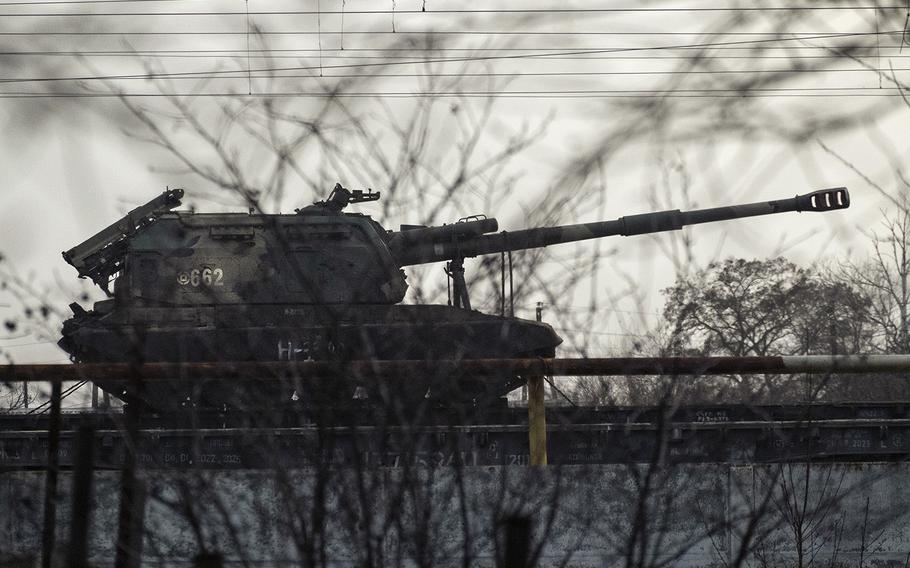Europe
AnalysisFive takeaways from an examination of the road to war in Ukraine
The Washington Post August 16, 2022

A Russian military column moves toward the border with Ukraine on Feb. 23, 2022. (For The Washington Post)
A months-long examination by The Washington Post of the road to war in Ukraine, including Western efforts to thwart the Kremlin's plans, is based on extensive interviews with more than three dozen senior U.S., Ukrainian, European and NATO officials. Here are some key findings:
1. The United States intelligence community penetrated multiple points of Russia's political leadership, spying apparatus and military, and found Vladimir Putin preparing for a full-scale invasion of Ukraine.
In the Oval Office in October 2021, President Joe Biden's top advisers presented him with Russian President Vladimir Putin's war plans for a full-scale invasion of Ukraine. U.S. intelligence agencies had used satellite imagery, intercepted communications and human sources to show that Putin was massing troops along Ukraine's border with the aim of seizing the capital, Kyiv, and much of the country, leaving only a rump Ukrainian state in the west.
The United States had discovered Putin sharply increasing funding for military operations while leaving his pandemic response underfunded. "We assess that they plan to conduct a significant strategic attack on Ukraine from multiple directions simultaneously," Gen. Mark Milley, chairman of the Joint Chiefs, told Biden. "Their version of 'shock and awe.'"
2. Every decision on arming Ukraine was predicated on not giving Russia a reason to attack the United States and NATO.
Biden was determined to rally NATO allies in the face of the impending invasion without provoking a direct conflict between Russia and the United States. Milley carried note cards in his briefcase encapsulating the U.S. interests and strategic objectives, as well as the high stakes. "Problem: 'How do you underwrite and enforce the rules-based international order' against a country with extraordinary nuclear capability, 'without going to World War III?'"
Every decision on arming Ukraine was predicated on not giving Russia a reason to escalate, often to the frustration of Ukrainian officials, who pressed the United States to send increasing numbers of more powerful weapons, even as they publicly doubted that the invasion would happen. "I make no apologies for the fact that one of our objectives here is to avoid direct conflict with Russia," said Jake Sullivan, Biden's national security adviser.
3. Biden dispatched his top intelligence official to confront Putin with evidence of Russia's war planning.
Biden sent CIA Director William Burns to Moscow to deliver Putin a message: We know what you're up to, and if you invade, there will be severe consequences. Burns delivered a personal letter from Biden, and he spoke to Putin by phone from an office in the Kremlin. The Russian leader had decamped to the resort city of Sochi during a coronavirus wave that placed Moscow under lockdown.
Putin, in a now familiar diatribe, complained about NATO expansion and the illegitimacy of Ukraine's government. "He was very dismissive of President [Volodymyr] Zelenskyy as a political leader," recalled Burns, a former U.S. ambassador to Russia. Burns concluded that Putin had not made an irreversible decision to invade. But, he reported back to Biden after the phone call, "my level of concern has gone up, not down."
4. Kyiv complained US intelligence wasn't specific enough to prepare for an invasion.
Ukrainian officials complained that whenever the Americans shared their bleak outlook about an imminent invasion, they never fully provided Kyiv with the details of their intelligence. In November, Ukraine's foreign minister and Zelensky's chief of staff visited the State Department in Washington, where a senior U.S. official greeted them with a cup of coffee and a smile. "Guys, dig the trenches!" the official said.
"When we smiled back," Foreign Minister Dmytro Kuleba recalled, the U.S. official said, " 'I'm serious. Start digging trenches. . . . You will be attacked. A large-scale attack, and you have to prepare for it.' "
"We asked for details; there were none," Kuleba said.
5. Zelensky suspected that some Western officials wanted him to flee.
The Ukrainian leader worried that with his government out of the way and a Kremlin-backed regime installed, NATO powers would seek a negotiated settlement with Moscow over Ukraine. "The Western partners wanted to — I'm sure someone was really worried about what would happen to me and my family," Zelenskyy said. "But someone probably wanted to just end things faster. I think the majority of people who called me — well, almost everyone — did not have faith that Ukraine can stand up to this and persevere."
Similarly, warning Ukrainians to prepare for war as some partners wanted him to, he said, would have weakened the country economically and made it easier for the Russians to capture. "Let people discuss in the future whether it was right or not right," Zelenskyy recalled, "but I definitely know and intuitively — we discussed this every day at the National Security and Defense Council, et cetera — I had the feeling that [the Russians] wanted to prepare us for a soft surrender of the country. And that's scary."